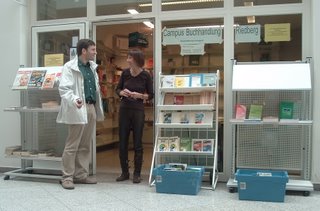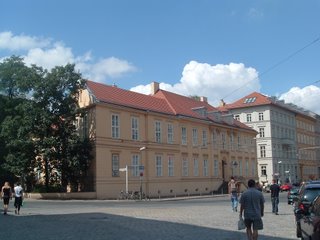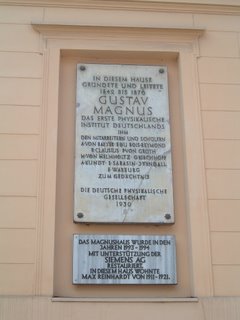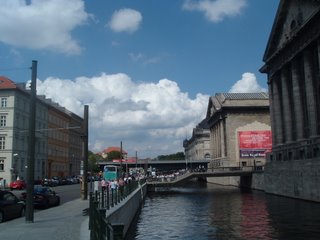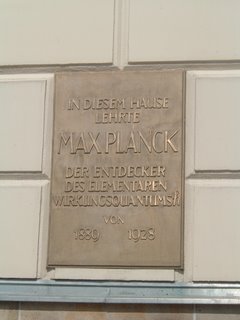Last night I had a nightmare! Bigfoot knocked at my door and wanted to talk to me about the existence of the string theory landscape. Still on east-coast time, I wiped off the sweat from my forehead but couldn't fall asleep again. I switched on my laptop, and decided its time to post the review on
Lee Smolin's new book.
Last week I surprisingly received an email from
his publisher who apparently doesn't mind me posting a review on my blog before the book is officially published. It seems the publisher's strategy is that every publicity is good publicity. Given the comments I had on his book, I can't say Lee looked very happy when I told him I'd write the review. So I thought it would be a nice gesture to let him add
some comments.
Anyway, since most of you haven't yet had a chance to read the book, I don't see any point in picking at details which I didn't like (there were plenty). So instead, this is more of a general summary of the book's content.
However, I want to point out that I did not read the final version and that some sections might have changed in the last revisions.
Lee's book analyzes the present stagnation that we experience in theoretical physics with the intention to understand its cause, and he proposes a strategy to ameliorate the situation. For this purpose, the presently most pressing problem in the US in investigated, that is the dominance of research by string theory, or better, the string community.
Even though the string community's lack of self-criticism is the obvious center of concern, the aim of the book goes far beyond confronting string theorists with the problems of the 'real world out there'. Building up on his examination of the current situation, Lee argues that the way scientific programs and researchers are supported today is inefficient under the present circumstances.
After some philosophical detours about the ethic of science, he eventually concludes with concrete proposals.
(From the introduction:)
"Why is physics suddenly in trouble? And what can we do about it? These are the central questions of my book."
The book is divided in four parts
Part I: The Unfinished Revolution
Part II: A Brief History of String Theory
Part III: Beyond String Theory
Part IV: Learning From Experience
The first part introduces the reader into the big five problems:
 | 1. The problem of quantum gravity |
 | 2. The foundational problems of quantum mechanics |
 | 3. The unification of the particles and forces |
 | 4. The values of the free constants in the standard model |
 | 5. Dark matter and dark energy. |
The following chapters then examine how historically great problems have been solved, what challenges have been met, and what detours have been made on this way.
The scientific level is easily accessible for anyone with an interest in the subject. It is a fascinating history from
Kepler's laws over
Maxwell's unification of electricity and magnetism, via
Einstein,
Kaluza and Klein's idea of extra dimensions to the
quark model,
Yang-Mills theories, and towards the
Standard Model. Two chapters are about the so-far unsuccessful searches for further unification (
grand unification,
technicolor,
preons,
supersymmetry...), and one further chapter is dedicated to the problem of
quantum gravity and background independence.
These chapters also provide the reader with a basis for the following parts and make the book fairly self-contained, though it is not recommendable as an introduction into the Standard Model or
General Relativity on its own.
The second part briefly summarizes the ideas behind
string theory, the problems that come along with it, what has been done to accommodate the problems, and what further problems followed.
By reading this history of string theory, it became clear to me why so many physicists were drawn towards string theory and its promises. It is a story full of surprising insights, successes and drawbacks.
But most of all, it is an unfinished story.
This part of the book is a very carefully written investigation of the achievements of string theory, and its failure to explain nature. It is a sometimes funny, sometimes sad description of the search for answers to the big five problems, whose pursuers lost their goal out of sight.
Subsequent chapters are dedicated to the first and second string theory revolution, and to recent developments in
AdS/CFT,
brane world scenarios,
KKLT,
the landscape and
the unavoidable anthropic principle. The part ends by evaluating the insights string theory has allowed us into the big five problems from part one.
The third part of the book then leads the reader through alternative research strategies to approach the big five. It introduces very recent developments like
deformed Special Relativity,
theories with a varying speed of light,
modified Newtonian dynamics. And Lee wouldn't be Lee if there wasn't a chapter about
Loop Gravity. He briefly mentions
non-commutative geometries,
causal dynamical triangulation, as well as
twister theory:
"Plainly, there are different approaches to the five fundamental problems in physics".
It is exactly the part that I found missing in
Peter Woit's book. Even though I could not avoid having the impression that the evaluation of promises and drawbacks in this part is less careful than in the previous part about string theory, it is an exciting journey! Unfortunately, it somewhat fuzzes out towards the end where Lee argues that "we have to find a way to
unfreeze time".
Though Lee told me that this part of his book is considerably improved in the final version, it still seems to me that these chapters are the optimist's antidote to the depressing conclusions from the previous part. As such they fulfill their purpose very well for the layman, who wants to get a glimpse on the variety of approaches by which we try to reveal nature's secrets. Those working in theoretical physics however, will be left with the desire for more details, and I hope that Lee's book succeeds in sparking a vivid discussion, as well as a critical evaluation, of string theory and the mentioned alternatives.
The fourth - and in my opinion most important - part then analyzes why and how science works best, what sociological problems we face, and under which circumstances research flourishes best. It addresses the problem of groupthink in the string community, the disastrous low-risk-attitude of current funding, and the inefficiency in hiring decisions when it comes to preserving diversity. Lee points out that many of today's research strategies might have been appropriate some decades ago, but do now hinder progress. Political pressure on young as well as senior scientists has grown to become a reason for concern. He concludes in a summarizing chapter
What can we do for science with a plea for open-mindedness and "intellectual freedom".
Lee tells a story of a frustrating time, of waiting, but also a story of hope. It's a story told by someone who knows what he is talking about, someone who has a vision, and who doesn't get tired repeating and fighting. Fighting for science to stay scientific.
It's a book that speaks of Lee's dedication for his work.
And I guess it wasn't an easy book to write, given the necessity to criticize what many of his colleagues and friends work on, and what he has worked on himself.
(From the intro)
"I can only insist that I am writing this book not to attack string theory..."
There is no doubt that a big part of the book
is a criticism of string theory. However, regarding the current situation, this was probably unavoidable. The last part of the book makes clear that its a constructive criticisms, and it sets a starting point for a scientific discussion about the future of theoretical physics.
It is a book written by someone who is deeply concerned about the future of theoretical physics. It is also a book by someone who clearly sees the mistakes made, even though the presentation is not always that clear. The book lacks structure in the 3rd and 4th part, and it requires a certain amount of patience to follow through some of the excursions. But many anecdotes and analogies make the book an entertaining read, and for a popular science book it is indeed very nicely written.
I am afraid this book will make many people who work on string theory and supersymmetry very very unhappy. But it will certainly influence those who currently consider going into theoretical physics. Maybe most important, it will encourage those who are frightened by the prospect to either give up their dreams, or to end up unemployed.
Aside:
I absolutely don't like the cover. The color choice is awful and the motive makes me wish I could knot up the strings to loops, such that whoever still wears shoes like this realizes his bad taste in clothing.
I can't tell you anything about the figures, except that there are some. In my version, the figures typically look like this: [[Figure 2: Query author, which picture is to be used?]]
Summary: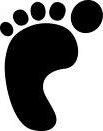
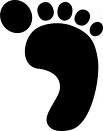
Some years ago I was traveling through South Africa. In one of the first guest houses where I stayed, the lady of the house asked me whether I had seen
Bigfoot. She spoke a very strange accent, so it took me some while to figure out she was actually asking whether I had seen the
'big five': lion, elephant, buffalo, leopard, and rhinoceros.
We are scientists. We should not loose the big five out of sight because we are searching for big foot's footprints in the landscape.
TAGS: SCIENCE, PHYSICS,
BOOKS
Notes added:
Update Sep. 19th 2007: The Trouble With Physics: Aftermath
TAGS: BOOKS,
PHYSICS,
TROUBLE

